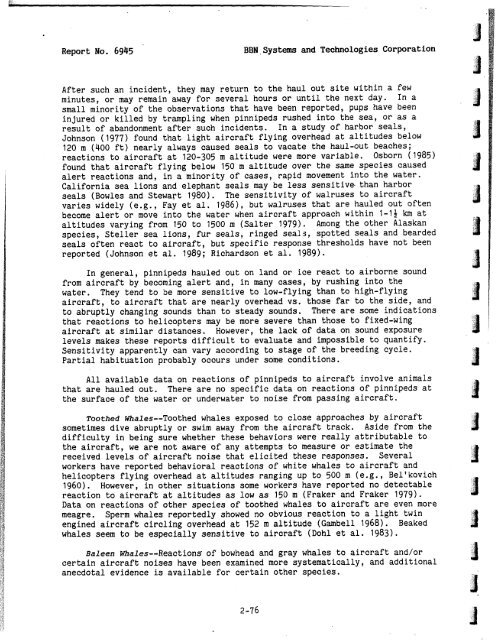Analysis and Ranking of the Acoustic Disturbance Potential of ...
Analysis and Ranking of the Acoustic Disturbance Potential of ...
Analysis and Ranking of the Acoustic Disturbance Potential of ...
Create successful ePaper yourself
Turn your PDF publications into a flip-book with our unique Google optimized e-Paper software.
Report No. 6945<br />
BBN,Systems <strong>and</strong> Technologies Corporation<br />
After such an incident, <strong>the</strong>y may return to <strong>the</strong> haul out site within a few<br />
minutes, or may remain away for several hours or until <strong>the</strong> next day. In a<br />
small minority <strong>of</strong> <strong>the</strong> observations that have been reported, pups have been<br />
injured or killed by trampling when pinnipeds rushed into <strong>the</strong> sea, or as a<br />
result <strong>of</strong> ab<strong>and</strong>onment after such incidents. In a study <strong>of</strong> harbor seals,<br />
Johnson (1977) found that light aircraft flying overhead at altitudes below<br />
120 m (400 ft) nearly always caused seals to vacate <strong>the</strong> haul-out beaches;<br />
reactions to aircraft at 120-305 m altitude were more variable . Osborn ( 1985)<br />
found that aircraft flying below 150 m altitude over <strong>the</strong> same species caused<br />
alert reactions <strong>and</strong>, in a minority <strong>of</strong> cases, rapid movement into <strong>the</strong> water.<br />
California sea lions <strong>and</strong> elephant seals may be less sensitive. than harbor<br />
seals (Bowles <strong>and</strong> Stewart 1980). The sensitivity <strong>of</strong> walruses to aircraft<br />
varies widely (e.g., Fay et al. 1986), but walruses that are hauled out <strong>of</strong>ten<br />
become alert or move into <strong>the</strong> water when aircraft approach within 1-14 km at<br />
altitudes varying from 150 to 1500 m (Salter 1979). Among <strong>the</strong> o<strong>the</strong>r Alaskan<br />
species, Steller sea lions, fur seals, ringed seals, spotted seals <strong>and</strong> bearded<br />
seals <strong>of</strong>ten react to aircraft, but specific response thresholds have not been<br />
reported (Johnson et al. 1989; Richardson et al. 1989).<br />
In general, pinnipeds hauled out on l<strong>and</strong> or ice react to airborne sound<br />
from aircraft by becoming alert <strong>and</strong>, in many cases, by rushing into <strong>the</strong><br />
water. They tend to be more sensitive to low-flying than to high-flying<br />
aircraft, to aircraft that are nearly overhead vs. those far to <strong>the</strong> side, <strong>and</strong><br />
to abruptly changing sounds than to steady sounds. There are some indications<br />
that reactions to helicopters may be more severe than those to fixed-wing<br />
aircraft at similar distances. However, <strong>the</strong> lack <strong>of</strong> data on sound exposure<br />
levels makes <strong>the</strong>se reports difficult to evaluate <strong>and</strong> impossible to quantify.<br />
Sensitivity apparently can vary according to stage <strong>of</strong> <strong>the</strong> breeding cycle.<br />
Partial habituation probably occurs under some conditions.<br />
All available data on reactions <strong>of</strong> pinnipeds to aircraft involve animals<br />
that are hauled out. There are no specific data on reactions <strong>of</strong> pinnipeds at<br />
<strong>the</strong> surface <strong>of</strong> <strong>the</strong> water or underwater to noise from passing aircraft.<br />
Too<strong>the</strong>d Whales--Too<strong>the</strong>d whales exposed to close approaches by aircraft<br />
sometimes dive abruptly or swim away from <strong>the</strong> aircraft track. Aside from <strong>the</strong><br />
difficulty in being sure whe<strong>the</strong>r <strong>the</strong>se behaviors were really attributable to<br />
<strong>the</strong> aircraft, we are not aware <strong>of</strong> any attempts to measure or estimate <strong>the</strong><br />
received levels <strong>of</strong> aircraft noise that elicited <strong>the</strong>se responses. Several<br />
workers have reported behavioral reactions <strong>of</strong> white whales to aircraft <strong>and</strong><br />
helicopters flying overhead at altitudes ranging up to 500 m (e.g., Bel'kovich<br />
1960). However, in o<strong>the</strong>r situations some workers have reported no detectable<br />
reaction to aircraft at altitudes as low as 150 m (Fraker <strong>and</strong> Fraker 1979).<br />
Data on reactions <strong>of</strong> o<strong>the</strong>r species <strong>of</strong> too<strong>the</strong>d whales to aircraft are even more<br />
meagre. Sperm whales reportedly showed no obvious reaction to a light twin<br />
engined aircraft circling overhead at 152 m altitude (Gambell 1968). Beaked<br />
whales seem to be especially sensitive to aircraft (Doh1 et al. 1983).<br />
Baleen Whales--Reactions <strong>of</strong> bowhead <strong>and</strong> gray whales to aircraft <strong>and</strong>/or<br />
certain aircraft noises have been examined more systematically, <strong>and</strong> additional<br />
anecdotal evidence is available for certain o<strong>the</strong>r species.
















